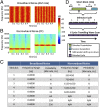Orthogonal acoustic dimensions define auditory field maps in human cortex
- PMID: 23188798
- PMCID: PMC3528571
- DOI: 10.1073/pnas.1213381109
Orthogonal acoustic dimensions define auditory field maps in human cortex
Abstract
The functional organization of human auditory cortex has not yet been characterized beyond a rudimentary level of detail. Here, we use functional MRI to measure the microstructure of orthogonal tonotopic and periodotopic gradients forming complete auditory field maps (AFMs) in human core and belt auditory cortex. These AFMs show clear homologies to subfields of auditory cortex identified in nonhuman primates and in human cytoarchitectural studies. In addition, we present measurements of the macrostructural organization of these AFMs into "clover leaf" clusters, consistent with the macrostructural organization seen across human visual cortex. As auditory cortex is at the interface between peripheral hearing and central processes, improved understanding of the organization of this system could open the door to a better understanding of the transformation from auditory spectrotemporal signals to higher-order information such as speech categories.
Conflict of interest statement
The authors declare no conflict of interest.
Figures





References
-
- Engel SA, et al. fMRI of human visual cortex. Nature. 1994;369(6481):525. - PubMed
-
- Sereno MI, et al. Borders of multiple visual areas in humans revealed by functional magnetic resonance imaging. Science. 1995;268(5212):889–893. - PubMed
-
- Brewer AA, Liu J, Wade AR, Wandell BA. Visual field maps and stimulus selectivity in human ventral occipital cortex. Nat Neurosci. 2005;8(8):1102–1109. - PubMed
Publication types
MeSH terms
Grants and funding
LinkOut - more resources
Full Text Sources
Other Literature Sources
Research Materials

